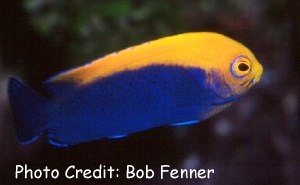
By Bob Goemans

Likely Reef Tank Suitable
Likely Fish-Only Tank Suitable
Range: Caribbean, south to Brazil
Size: 2.5 inches (6 cm)
Natural Environment: Inhabits outer reef faces and slopes, often areas containing patches of Staghorn coral, and is found at wide ranges of depth, sometimes below 600 feet (190 m). Feeds mainly on algae and sponges.
General Husbandry: This hardy dwarf angelfish is quite beautiful as it has a blue body with its head and back areas a golden yellow, and its eyes surrounded by a thin blue ring. Not always readily available in the trade, but when so, makes a nice addition to most reef aquariums. Because of its natural secretive instincts its highly recommended it be added to only well established aquariums containing lots of live rock that will provide it many caves and crevices to explore and/or hide in when feeling threatened.
Its an excellent browser of algae, and will also accept a wide variety of frozen foods including fortified brine shrimp, mysis, and flake food, especially Spirulina. Two feedings per day is highly recommended, as underfed specimens have a tendency to pester corals and other invertebrates. Its also recommended there be only one species from this dwarf angelfish genus in the aquarium, as they tend to develop aggression toward other dwarf angelfish species. One of the more sociable of the genus, yet can be quite shy when first entering the aquarium and will hide in caves and crevices. But as time passes, will be more outgoing and become a good community fish.
Keep in mind they are not suited for small nano style aquariums, as they can become very aggressive in small surroundings, and furthermore, without numerous feedings per day, be able to find enough food to be maintained long-term.
Taxonomy:
Order: Perciformes
Suborder: Percoidei
Family: Pomacanthidae
Genus: Centropyge
FYI: All Centropyge species start life as unsexed individuals, but begin their adult life as females. Then, the larger or more dominant individual within small groups will change sex within a few days to a couple of weeks and become a male. Knowing that size is the main difference between the sexes, and not so much its coloration, all one needs to do is place a small and larger specimen together. Within approximately sixty days one of the two fish will have physically changed sex to accommodate the other. A reversal of this sex change is possible if the need arises, but that requires much more time, e.g., weeks to months.
Keep in mind all angels have cheekspines at the edge of their gill cover; therefore use caution when handling and also avoid using a net to capture it, as it may become stuck or tangled in the net and become damaged when removed.
Experience Level: Intermediate
Temperament: Peaceful
Diet: Omnivore
Acclimation Time: 30 minutes+
Aquarium Environment: Reef aquarium (see below) or fish-only aquarium
Reef Safe: With caution – underfed specimens have a tendency to nip clam mantles, sea anemones, large–polyped stony (LPS) corals and some soft corals such as zoanthids.
Minimum Tank Size: 50 gallons
Temperature Range: 68 - 82°F (20 – 27°C).
Specific Gravity: 1.020-1.027
pH: 8.0 - 8.5
